When it comes to Japanese restaurant interior design, it’s about more than just creating a beautiful space, it’s about crafting an experience that stays with guests long after the meal ends. Every detail, from the texture of the wood to the flow of the layout, shapes how diners feel, move, and connect with their surroundings. The best restaurant interior design blends timeless Japanese tradition with modern innovation, creating spaces that are serene yet vibrant, simple yet sophisticated. Today’s Japanese restaurants aren’t just places to eat, they are immersive environments where each visit feels thoughtful, welcoming, and unforgettable.
Exploring the Core Principles of Japanese Restaurant Design
The foundation of Japanese restaurant design lies in mindfulness and intention. Every object, colour, and texture is selected to create a serene and welcoming environment. Key aspects include:
- Minimalism:
Open, uncluttered spaces help diners feel calm and focused. Minimalist restaurant design is not about emptiness; it’s about thoughtful placement of furniture, décor, and functional elements to create a sense of order and clarity.
- Natural materials and neutral tones:

Using wood, stone, bamboo, and linen adds warmth and tactile richness to a space. These materials bring a sense of nature indoors, creating a connection to the environment while enhancing comfort and authenticity.
- Wabi-sabi:

This Japanese philosophy finds beauty in imperfection, simplicity, and the passage of time. In a restaurant setting, it might appear as hand-crafted pottery with subtle irregularities, slightly uneven wooden textures, or natural wear in décor elements. These minor “flaws” create authenticity and warmth, giving the space character and a sense of quiet, understated elegance.
- Balanced lighting and spatial harmony:
Thoughtful layouts and lighting create a sense of calm and ease. Diffused light, carefully positioned fixtures, and intuitive pathways guide movement and interaction, while maintaining a welcoming and serene atmosphere.
Together, these elements create dining spaces where guests feel grounded, engaged, and relaxed, making the restaurant more than just a place to eat; it becomes an experience.
Bringing Nature Indoors: Biophilic and Japandi Interior Design

Biophilic design, which connects people to nature, is increasingly central in modern Japanese restaurants. By integrating natural elements, restaurants create spaces that are relaxing, restorative, and visually appealing:
- Warm wood, bamboo, and stone finishes add texture and authenticity.
- Indoor greenery, bonsai trees, and subtle plant arrangements breathe life into interiors.
- Open layouts, large windows, or courtyards invite sunlight and fresh air.
- Water features, like small fountains or reflecting pools, add a sense of tranquillity and a subtle soundscape.
This approach complements Japandi interior design, a fusion of Japanese minimalism and Scandinavian simplicity, which emphasises comfort, natural materials, and uncluttered living. It’s about creating spaces where diners feel calm but not isolated.
Contemporary Twists on Tradition in Japanese Restaurant Design
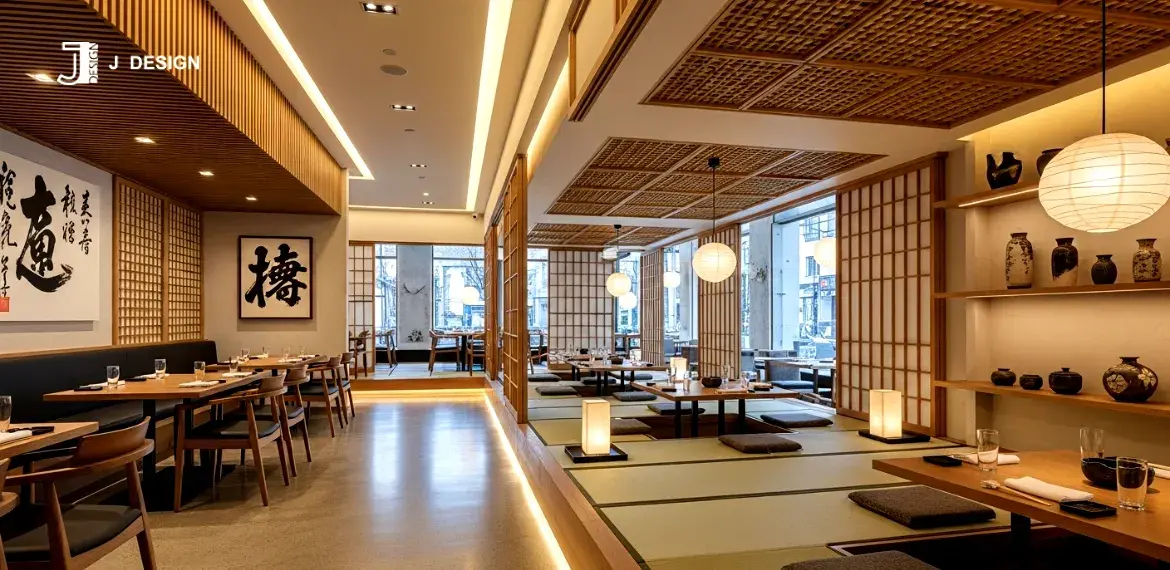
Modern Japanese restaurants are redefining tradition by blending old-world charm with contemporary design:
- Furniture & layout: Sleek, low-profile seating alongside traditional tatami-style arrangements strike a balance between authenticity and comfort.
- Materials: Shoji screens, washi paper, or bamboo can coexist with polished concrete, glass, or metal to achieve a refined look.
- Art and cultural touches: Carefully curated installations, such as calligraphy or ceramic pieces, add character without overwhelming the space.
- Lighting innovation: Modern LED or sculptural lighting enhances architectural lines while maintaining a warm and inviting ambience.
This fusion of heritage and innovation makes dining spaces feel fresh, unique, and culturally respectful, offering both visual delight and functional comfort. If you want a stunning and functional restaurant space, J Design’s restaurant interior design services can make it happen.
Lighting and Ambience in Modern Japanese Restaurants
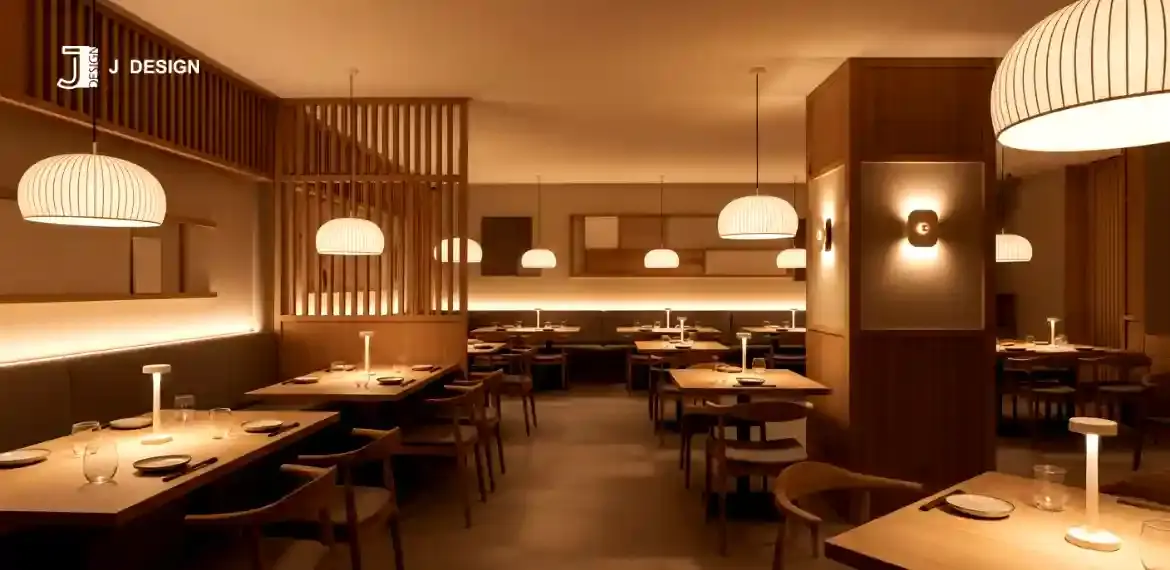
Lighting defines mood and experience in every restaurant:
- Soft, diffused lighting creates an intimate atmosphere, allowing diners to relax and focus on their meal.
- Lantern-inspired fixtures add cultural authenticity and warmth, evoking the traditional Japanese aesthetic.
- Layered lighting, combining ambient, accent, and task lights, draws attention to design elements, culinary presentations, and seating zones.
Adequate lighting also influences perception of space, making compact areas feel open or larger spaces feel cosy, while setting the stage for memorable dining experiences.
Layout and Space Planning for Restaurants
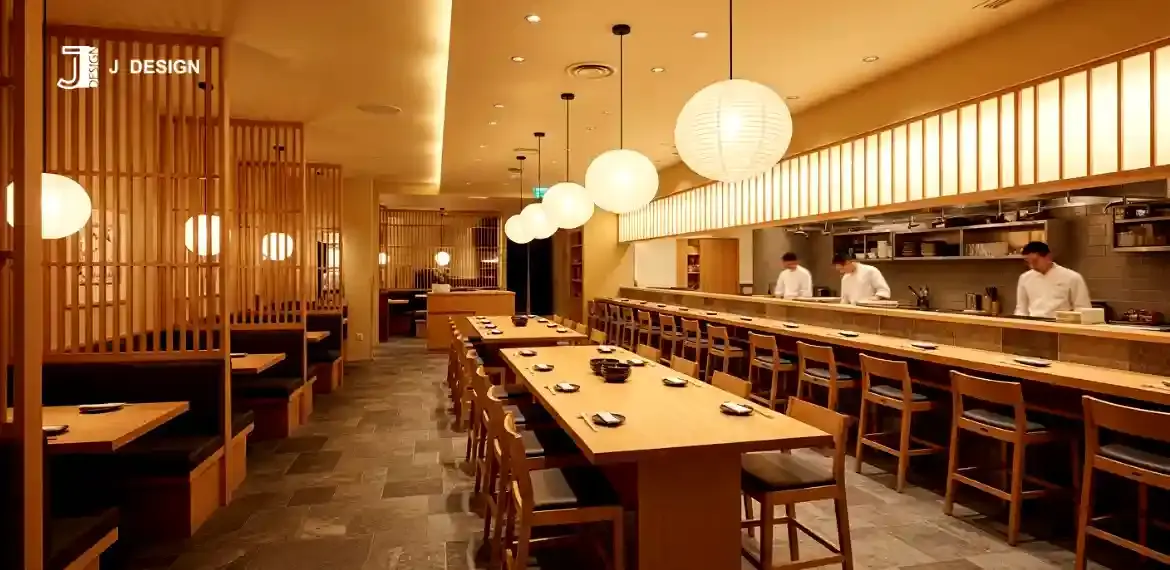
A thoughtful layout improves comfort, flow, and interaction:
- Private booths offer intimacy for couples or small groups.
- Open communal tables foster social dining and a lively atmosphere.
- Counter seating highlights the culinary process, connecting diners to chefs and enhancing engagement.
- Flow and movement: Clear pathways reduce congestion, improve staff efficiency, and enhance the overall dining experience.
A good layout strikes a balance between openness and privacy, making the diners feel both relaxed and engaged with the restaurant’s atmosphere.
Colour Palette and Texture Choices for Japanese Restaurants
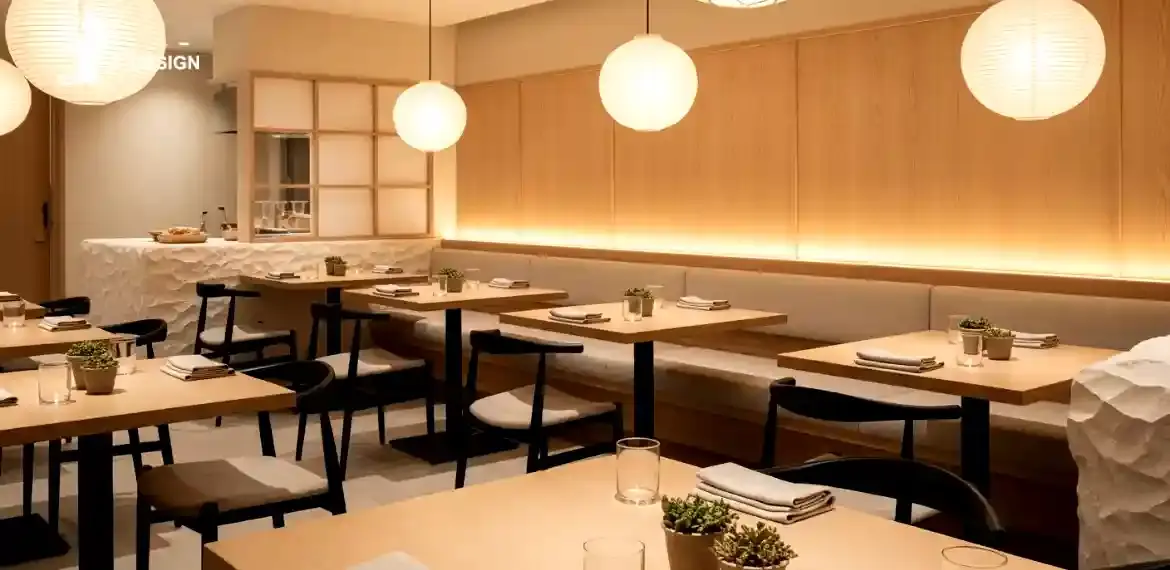
Colours and textures create mood, depth, and sensory harmony:
- Neutral palettes, featuring soft beiges, creams, and warm browns, foster a sense of calm.
- Accent tones, such as black, deep red, or earthy green, add visual interest and energy without overwhelming the space.
- Textural contrasts, combining smooth stone, rough-hewn wood, paper, and linen, create tactile richness that engages multiple senses.
This approach embodies minimalist restaurant design and Japandi style, resulting in spaces that feel cohesive, balanced, and visually pleasing.
Integrating Technology Without Compromising Tranquillity
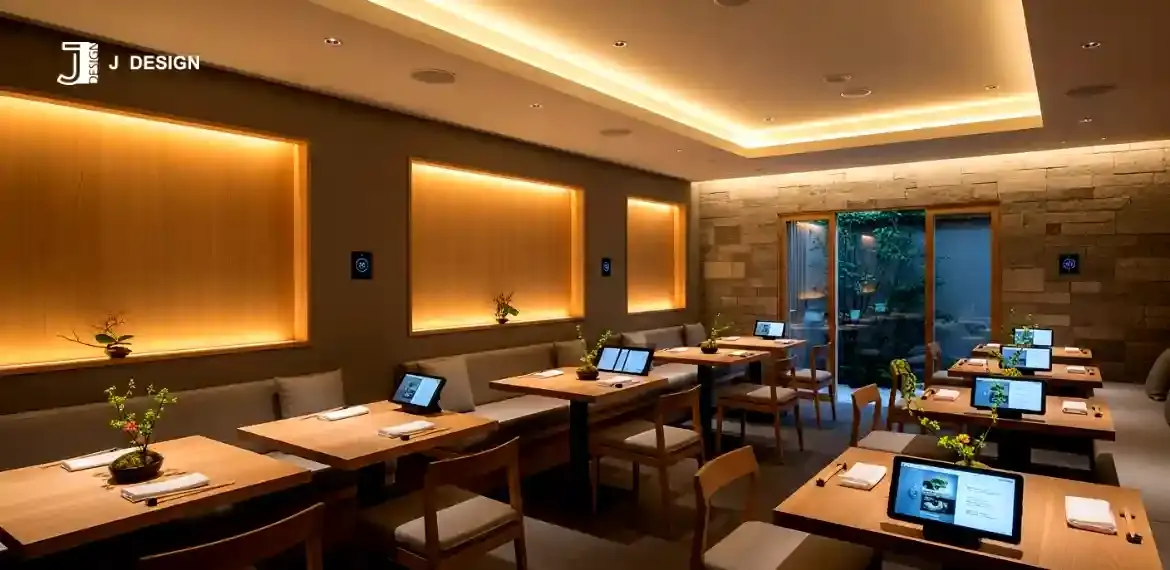
Technology can enhance convenience without compromising serenity:
- Bright lighting and climate control maintain optimal comfort at various times of day.
- Minimalist digital menus or tablets offer efficiency while blending with décor.
- Discreet audio systems provide background music or natural soundscapes to support the calming atmosphere.
The key is subtlety; technology should support the dining experience without becoming the focus.
Designing for the Modern Diner

Modern diners expect spaces that are functional, stylish, and shareable:
- Visual appeal for social media, with Instagram-friendly settings that feel natural and unstaged.
- Compact yet comfortable layouts for urban areas with limited space.
- Sustainable and eco-conscious materials resonate with eco-minded guests, from reclaimed wood to low-energy lighting.
Restaurants that understand these needs create a stronger emotional connection with their guests, increasing loyalty and satisfaction.
Conclusion
Japanese restaurant interior design masterfully blends timeless tradition with modern innovation to create spaces that are both calming and visually stunning, making them truly memorable. From minimalistic layouts and natural materials to ambient lighting, greenery, and carefully curated décor, every detail is designed to engage the senses and enhance the dining experience.
By harmonising authenticity, comfort, and contemporary style, often inspired by Japandi interior design principles, these restaurants not only offer a meal but an immersive experience that lingers in the mind, making each visit feel thoughtful, welcoming, and unforgettable.
For businesses seeking to achieve this level of design, J Design offers expert interior design services to bring visionary spaces to life.
FAQs
What is Japan’s interior design style?
It focuses on simplicity, natural materials, clean lines, and neutral colours to create calm, balanced, and functional spaces.
What are the cultural influences in Japanese interior design?
Influences include Zen philosophy, wabi-sabi (the beauty of imperfection), nature, and traditional elements such as tatami mats and shoji screens.
What is Japanese-style dining called?
Traditional dining is known as washoku, often featuring tatami-style seating or counter dining at sushi and teppanyaki restaurants.
What is F&B interior design?
It’s the design of restaurants, cafes, and bars that combines aesthetics, functionality, and customer experience to create an exceptional dining space.
What is teppanyaki style?
A Japanese cooking style where chefs prepare food on an iron griddle in front of guests, usually with counter seating for interaction.
